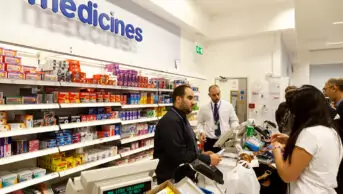
Shutterstock
NHS 111 replaced the telephone triage and advice services provided by NHS Direct, NHS24 and local GP out-of-hours services over three years ago as England and Scotland’s freephone non-emergency medical helpline.
The service is staffed by a team of advisers — the call handlers — who are trained to use the NHS Pathways algorithm to assess patients, and give healthcare advice or direct them to their local A&E department, an out-of-hours doctor, urgent care centre or a walk-in centre, community nurse, emergency dentist or community pharmacy as appropriate.
The advisers are supported by nurses and paramedics, who provide the next level of clinical backup for calls that do not obviously fit into the algorithm and, while NHS Pathways training will license only these two clinical professions to be clinical advisers, there are also roles for pharmacists interested in working in urgent care.
John O’Sullivan is Kent, Medway, Surrey and Sussex (KMSS) 111 head of service at the South East Coast Ambulance Service (SECAMB), which handles more than 1.2 million calls a year. O’Sullivan is the only pharmacist in charge of an NHS 111 service. He also sits on the National Integrated Pharmacy working group of NHS England (the body that sets the priorities and direction of the NHS and commissions healthcare services in England), is group pharmacy superintendent pharmacist for the six pharmacies in the Ackers Chemists Group, and has recently joined Kent Local Pharmaceutical Committee (an organisation representing all NHS pharmacy contractors in a defined area) as an independent representative.
O’Sullivan sees community pharmacy as “the signpost agents in the high street”, which he says gives “a natural alignment between pharmacy and 111”. But because community pharmacists are not licensed as clinical advisers within the service, their remit is to deal only with medicines advice, which O’Sullivan believes does not use the full range of their skills.
Typical enquiries
This lack of scope has not put off pharmacist Zafiat Quadry from getting involved. She qualified in August 2010 and is a medicines management pharmacist at a clinical commissioning group, an NHS organisation responsible for the planning and commissioning of healthcare services for their local area, and also works at an NHS 111 call centre for Integrated Care 24 at the weekends as a pharmacist adviser.
She says: “Most calls we deal with are about medicines advice around drug interactions and potential toxicity cases. Calls can vary from what happens in the home, such as children drinking paracetamol or eating washing powder capsules, to more complex problems around controlled drugs.
“Other issues include travel health and vaccines queries; calls from carers; questions about [emergency hormonal contraception]; people asking whether they can take warfarin before surgery; and lots of queries about repeat medicines, especially at the weekends from patients in rural areas where their local community pharmacy may be closed on a Saturday afternoon.”
Training and experience
Quadry says what most people want is usually “clear reassurance”, and Martin Burnside, a front line pharmacy adviser at NHS 24 — Scotland’s national telehealth and telecare organisation — says this is where “community pharmacy training and experience is useful for dealing with minor ailment calls.”
He adds that training is provided on the job, including on the use of Toxbase, the online database of the National Poisons Information Service, which is necessary for dealing with overdose calls or accidental poisonings.
Fatima Sabir is an independent pharmacist prescriber at a GP practice in Wakefield, West Yorkshire, and has worked at NHS 111 at Yorkshire Ambulance Service NHS Trust (YAS) since 2013. She is now a senior pharmacist adviser involved in training newly recruited pharmacist advisers and providing pharmaceutical related training to YAS staff.
Sabir says it is “essential to have a least three years’ experience as a pharmacist, although we are currently recruiting and looking for pharmacists with four to five years’ experience, a clinical diploma and some hospital or primary care experience”.
Skills and qualities
Training aside, O’Sullivan says a plus point for pharmacists is that they already have excellent clinical decision-making skills, for evaluating symptoms and the clinical risk of patients.
Burnside says some of the most challenging calls coming into the service are those which involve overdose or accidental poisoning, which is where pharmacists often demonstrate their strengths.
“A quick and accurate decision is needed in order to ensure a safe patient outcome,” he says, “whether [that is] advising that the patient doesn’t require assessment, or that they present at A&E themselves, or even having to arrange an emergency response ambulance”.
You need to be sure that the caller understands what you are asking and you understand what they are telling you
Quadry adds: “You need to be able to interpret complex clinical information from the resources available, and be able to do that in a timely manner because you’ve got the patient on the phone.”
Sabir believes that alongside these fast decision-making skills a “thick skin” is necessary, because the job can be stressful — patients are often worried and unhappy, and may be angry.
Good communication skills are also a must, because dealing with someone on the phone is different from face-to-face communication. “You need to be sure that the caller understands what you are asking and you understand what they are telling you,” Quadry explains. “For instance, imagine if someone is calling about a rash; you can’t even see it. I’ve found my independent prescribing training and postgraduate diploma have helped because I did a lot of work around consultation.”
Further challenges
Not having the patient in front of you can cause other challenges, according to Burnside: “The patient’s reason for calling may not always be the most clinically important issue at the time.” He adds: “For example, an elderly patient may phone asking if she can increase her dose of ranitidine when in actual fact the most pressing issue at hand could be that this patient is suffering from chest pain due to a cardiac event.”
There are additional factors that are out of your control, relating to both the patient and to health care services that the patient may need to be referred to. Quadry says: “In some cases people decide not to take your advice and take a different course of action, which can be difficult because you wonder what has happened to them once they put the phone down. You’ve also got to manage patients’ expectations. For example, I can advise someone that I will request a GP to give them a call but it will be down to the GP to decide what is most appropriate thereafter; that is out of my hands.”
For O’Sullivan, a hurdle can be “convincing people that pharmacists do more than count pills”. Quadry agrees: “There is still further work we need to do with providers of the service so that they fully understand the benefits that independent pharmacist prescribers can bring to improving the patient experience as part of a team of health professionals.”
Another issue is the expense of getting insurance to undertake this kind of work, something that Quadry stresses: “I’d like to highlight the issue of personal professional indemnity cover for the role, which is something that needs to be worked through for the benefit all of us in this profession.”
Integrated working
Despite the challenges, the roles available offer a chance to be involved in a multidisciplinary team. Quadry says: “As a clinician I love that I am surrounded by a team of people from different clinical disciplines, and I’ve learned so much that I probably wouldn’t have come across in hospital or community pharmacy.”
Sabir also enjoys the interdisciplinary network of a range of professionals working together and “the fact that I learn something new every single day.”
Future prospects
Unscheduled care is a vital part of healthcare provision in the NHS, and Burnside believes there are plenty of career trajectories for pharmacists working in the service: “There will always be further development opportunities for those who seek them out.”
Nonetheless, many pharmacists lament the current lack of opportunity for them to join nurses and paramedics as clinical advisers within the service.
Sabir says: “Many prescribers like me would be happy assessing patients and providing further medicines advice, but I can’t do this because I am not able to do the clinical adviser training. I think NHS 111 is missing a trick here by not making the most of pharmacists, as they used to when NHS Direct existed.”
Thankfully, O’Sullivan offers a glimmer of hope: “The whole integrated urgent care landscape is changing quickly and pharmacists are seen by NHS England as being an absolutely key part of that integration — we can make a difference because of our sheer numbers. I sit on the NHS England National Integrated Pharmacy working group and, for my part, I am working hard to allow pharmacists to be accredited as NHS Pathways clinical advisers and bring them into the fold.”
Reading this article counts towards your CPD
You can use the following forms to record your learning and action points from this article from Pharmaceutical Journal Publications.
Your CPD module results are stored against your account here at The Pharmaceutical Journal. You must be registered and logged into the site to do this. To review your module results, go to the ‘My Account’ tab and then ‘My CPD’.
Any training, learning or development activities that you undertake for CPD can also be recorded as evidence as part of your RPS Faculty practice-based portfolio when preparing for Faculty membership. To start your RPS Faculty journey today, access the portfolio and tools at www.rpharms.com/Faculty
If your learning was planned in advance, please click:
If your learning was spontaneous, please click:
You may also be interested in

Tackling the NHS drug budget: why we set up a regional collaboration for medicines value

Lack of joined-up working between pharmacy and general practice is ‘nonsensical’, says former BMA chair
